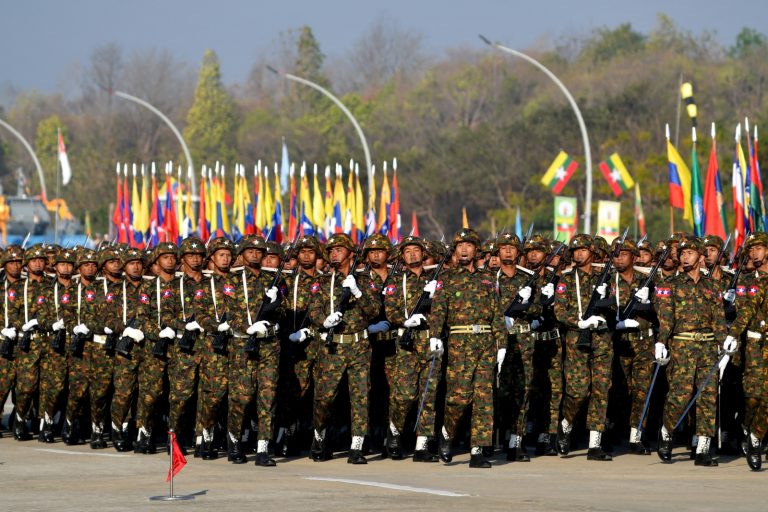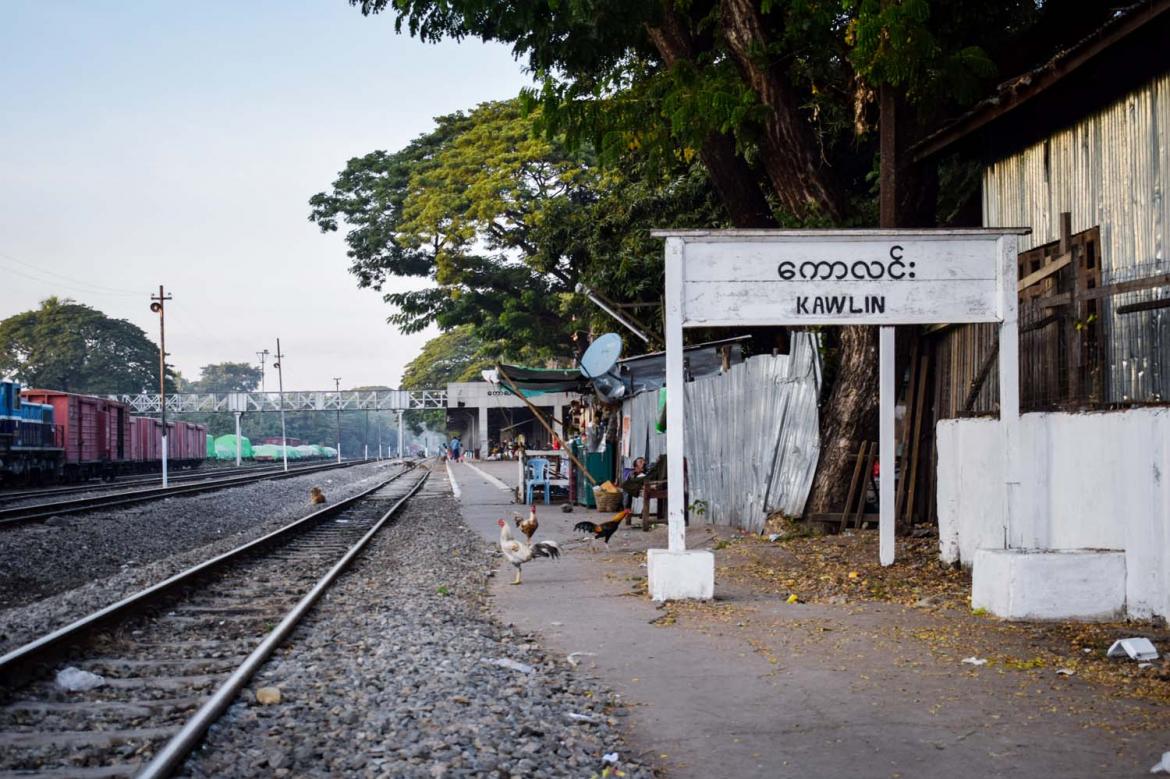An entertainer with a gift for oration is keeping junta forces on their toes in Sagaing Region, while building a united front of anti-coup armed groups.
By FRONTIER
Hundreds of villagers gathered in a dusty village in southern Sagaing Region, their voices loudly chanting revolutionary slogans against the backdrop of a blazing orange February sunset. They were waiting to hear Bo Thaw Ka, the charismatic 38-year-old leader of one of Ayadaw Township’s People’s Defence Forces, give one of his trademark speeches.
Wearing an army bush hat, plain shirt and longyi, and accompanied by an escort of PDF fighters armed with home-made guns, Thaw Ka made his way to the stage to the riotous cheers of the crowd.
“What will we do when the junta’s forces come?” he said in a gruff tone through a small loudspeaker.
“We will fight,” roared the crowd.
“No!” he replied, “We will run. We have to run, but as soon as they leave, we will return and rule our village.”
Thaw Ka is an effective orator, a skill he acquired in his previous role as a “byik silk”, a kind of master of ceremonies/entertainer at traditional Bamar events such as weddings or novitiations. The involvement of byik silk, who intersperse Buddhist blessings with jokes and banter, is regarded as auspicious at such events. Since the coup, Thaw Ka has been using these skills to lead protests and help villages organise local defence forces.
As the gathered villagers listened intently, he continued his address, explaining that ethnic armed groups were helping the resistance in Sagaing and Magway regions to fight back against marauding columns of soldiers.
“Without the ethnic armed group, we can never achieve our goal because our goal is not only to defeat dictators, but also to create equality and freedom,” he said.
His speech was slow, calm and peppered with jokes. But, despite the humour, his expression remained serious and the eyes beneath the brim of his green bush hat burned with intensity.
In his previous life as a byik silk, Thaw Ka entertained crowds and dispensed blessings wearing shiny satin clothes and the traditional Burmese turban known as a gaung baung. This time, as he stood before the crowd, he said he had no blessing to offer. “This country has not been blessed since the coup.”
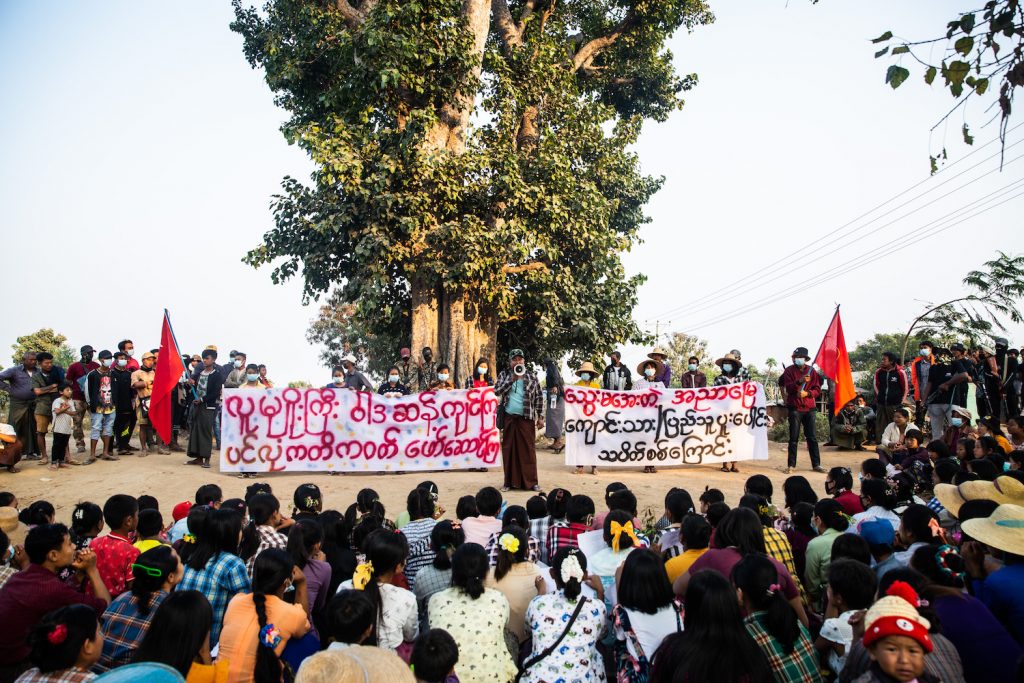
From clown to warrior
After his speech, Thaw Ka invited Frontier to travel to his home village of Shauk Khar in northern Ayadaw Township, which also serves as the base of the PDF he leads.
The journey consisted of a 45-minute motorcycle ride along yellow dirt roads lined with dry paddy fields. The road was cratered in places where the PDF had used improvised explosive devices to attack junta convoys. PDF fighters escorted their leader back to the base, the mood relaxed as regime troops do not often stray this far north.
More fighters manned a checkpoint at the entrance to the village, where they inspected the convoy for weapons, drugs and gambling paraphernalia. In normal times, the main crops grown around Shauk Khar are peanuts and sesame, but the main activities during Frontier’s visit were those focused on fighting the junta. In the sprawling compound where Thaw Ka lives was a workshop for making weapons, a big kitchen for preparing meals for PDF fighters and a small shooting range for testing weapons.
Settled back in his home, Thaw Ka shared the story of his colourful life. He left Shauk Khar at 15 and joined a traditional performance troupe, playing the roles of a clown and a singer for 10 years. He decided to become a byik silk and began studying the Buddhist verses and other stories that he needed to master. Eventually, he became one of the most renowned byik silk performers in the central dry zone regions of Sagaing, Magway and Mandalay, a distinction he enjoyed until the coup.
“In the past, I haven’t even killed a bird,” he said. He said it again, then continued, “I wanted to spend my life just singing songs and telling funny stories.”
The conversation was occasionally interrupted by incoming calls on his phone: the ringtone was a recording of his performance of a National League for Democracy campaign song for the 2020 election. Thaw Ka is a staunch NLD supporter and joined the protests when the party was overthrown in February 2021, after winning a landslide reelection in November 2020. His decision to take up arms against the military came in mid-2021, after the crackdowns on protesters became increasingly deadly and brutal. He began by organising the residents of Shauk Khar and built a secret camp near the village before recruiting men and seeking weapons to form a rebel group.
Thaw Ka was among the thousands who have chosen the path of resistance in the central dry zone, where young teachers became assassins, farmers made improvised explosive devices, and even monks became rebel leaders.
It was as if everyone had been reborn. “I told my men that even if the junta could conquer the whole country, they will not conquer my village,” he said.
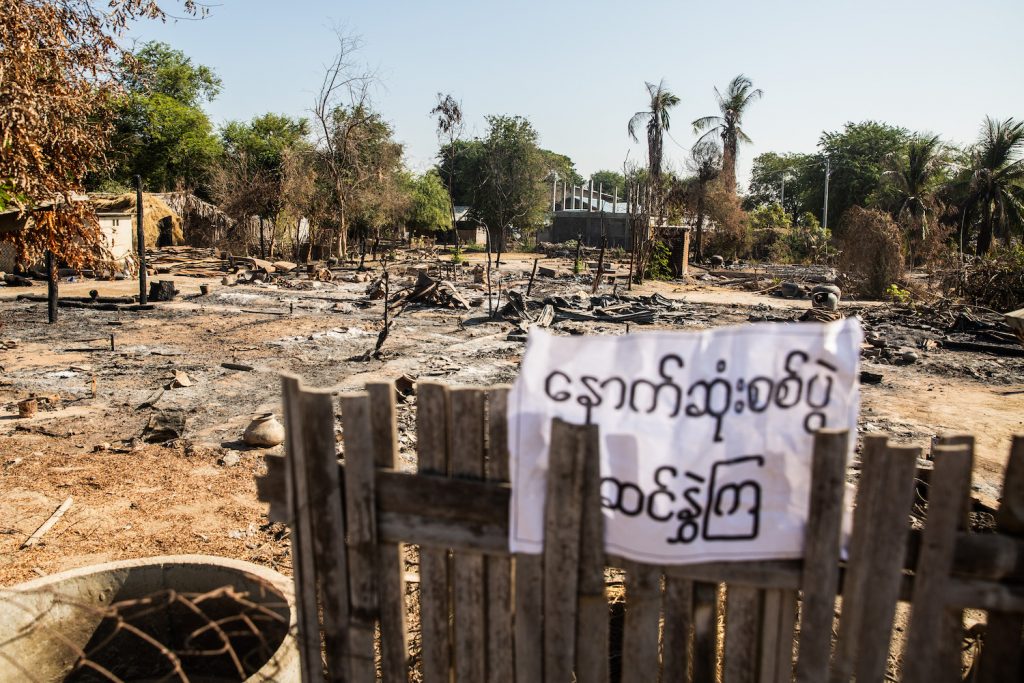
A wanted man
According to Thaw Ka, his PDF is one of the strongest in the area, partly because it is one of the best armed. Many of Ayadaw’s 155 villages have attempted to form PDFs, and there are an estimated 20 groups currently operating in the township. While some have submitted to the command of the parallel civilian government, the National Unity Government, others are cooperating with NUG’s forces while maintaining their independence.
Thaw Ka’s PDF is among the former and receives direct support from the NUG. He said that this has enabled his PDF to have more effective weapons and better financing than other local groups. His PDF also works with the NUG’s local administration, known as People’s Administration Teams, and helps the PATs provide government services and local administration.
“We’ve made a lot of progress and had to overcome many challenges to reach this stage. That’s one of the reasons junta forces have tried to kill me several times,” Thaw Ka said.
The first attempt on Thaw Ka’s life came last October, when junta forces stormed the PDF’s secret camp near Shauk Khar village. The PDF was tipped off and everyone managed to escape. The soldiers set fire to the camp, and the incident left Thaw Ka suspicious about the presence of informers in his village.
“The incident made me realise that it is not easy for revolutionaries to operate in villages where people who are pro-military have not been eliminated,” he told Frontier.
Three weeks later, four people thought to be Tatmadaw sympathisers and a member of the military-backed Union Solidarity and Development Party in Shauk Kar village were killed.
A neighbour who witnessed the killing of one of the victims, U Tun Shwe, said that the man hid in his house and attempted to fend off his killers with his own gun. The neighbour said that Tun Shwe attempted to apologise for his actions but was killed shortly after. Thaw Ka referred to those killed as informers who placed the PDFs in danger.
A group that called itself the Ayadaw Ninjas later claimed responsibility, releasing a statement alleging that the victims had relatives in the Myanmar military and had been providing names of PDF members to soldiers. The Ayadaw Ninjas also accused two of the victims of attending trainings provided by the military and bringing provisions to the soldiers. They claimed that ammunition was found in their homes and accused the victims of becoming wealthy after the coup.
On November 11, the day after the killings, the military returned to Shauk Khar. Thaw Ka’s house was the first to be burned that day. However, he had anticipated such an eventuality and had fled before the troops arrived. Unable to find Thaw Ka, the soldiers torched 10 more houses.
“They thought we would be scared if they burnt down our homes but we are not afraid anymore and we hate them even more,” said Ko Kyin Wai*, a village resident and PDF member.
Kyin Wai showed Frontier the ruins of Thaw Ka’s house. There were scorched pots and pans and the remains of water pumps and tractors. Kyin Wai salvaged some short lengths of iron from the ashes. “Short pieces of iron are useful,” he said. “They can be used to make mines.”
As a contingency against raids by soldiers, Thaw Ka has encouraged village residents to prepare emergency supplies to take with them for when they needed to flee.
“It is nothing new for junta forces to burn villages that do not support them. In the surrounding villages they have even committed mass killings,” said a 40-year-old woman resident of Shauk Khar whose house had also been torched.
On April 8, junta forces returned to Shauk Khar for a third time. They attempted to launch a surprise attack at 2am in the morning when it was raining, but PDF members saw them and a battle ensued. The soldiers fired mortars and field guns at the village while Thaw Ka and his PDF fighters returned fire with their handmade guns.
“We only have a few modern firearms and are mostly armed with handmade guns, which we used along with explosives for about 30 minutes to delay their advance to give the villagers time to flee,” Thaw Ka said.
The attack left one villager dead and another 50 homes incinerated. After the junta forces left, the villagers returned, distraught at the torching of their homes. Thaw Ka led the rebuilding effort and rallied the villagers, urging them to stay strong.
“When they set your house on fire, do not be sorry, be angry,” he said.
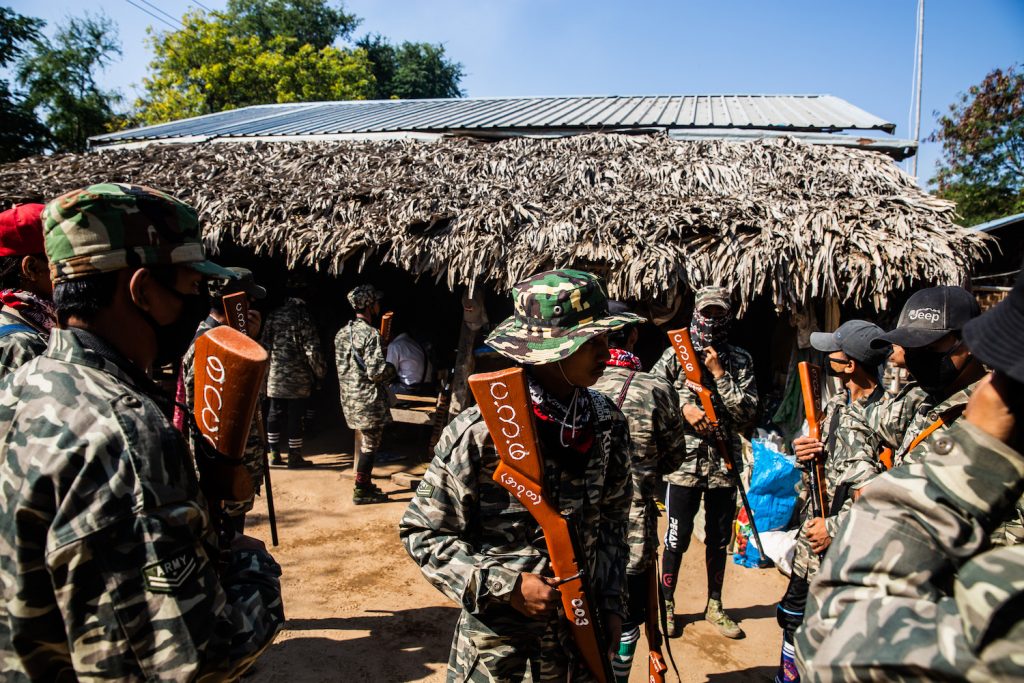
A united front
Resistance to the military coup has been especially strong in Sagaing Region, in part due to the work of people like Thaw Ka, but that strength has meant the region has been subject to some of the most brutal junta attacks in the country. According to the NGO Data for Myanmar, regime forces have set fire to over 7,000 houses in Sagaing between January and April of this year alone. The junta has also been targeting civilians in an effort to cut off support and supply lines to the PDFs that seek to defend them.
In late April the military launched another series of mass killings and arson that terrorised communities where PDFs were active in Sagaing Region. It continued until the end of May. Khin-U and Ye-U townships, to the north of Ayadaw, were the first to feel the brunt of the attacks. PDFs in Ye-U and Chaung-U told Frontier that about 70 people were killed between April and May in Ye-U and Chaung-U. In Khin-U, more than 1,000 houses from 30 villages were reduced to ashes and over 10,000 villagers are still displaced, the township’s information team told Frontier by phone in May.
Some fighters believe that a united front of NUG-affiliated PDFs and other local armed groups might have been able to turn back the attacks, but ideological and personal differences and problems over territory have been a barrier to unity.
“Local armed groups wanted to start fighting immediately. But some NUG PDFs were slow to respond and could not come to dance when we needed them, so it was not possible to form a strong united front,” a Khin-U resident told Frontier by phone. “Dancing” is a slang term for fighting.
Ayadaw has been an exception as one of the few townships in Sagaing Region where groups have been able to coalesce and establish a fighting coalition. Thaw Ka and his NUG-affiliated PDF have joined forces with about 10 other groups in northern Ayadaw Township. His PDF is also part of the Northern Brotherhood Alliance Revolution (NBAR), which consists of five groups, and are in allyship with the North West Plain Squad (NWPS) of Depayin Township. He claimed the alliance was able to muster some 600 troops, although Frontier could not independently verify this number. Thaw Ka said that these groups have been coordinating attacks and making deals to enforce the “rule of law” in the groups’ respective territories.
Thaw Ka said that his PDF has also been supplied with weapons from the Kachin Independence Army, and that he has shared these weapons with groups allied to his fighters.
“I absolutely accept allies and the need for a united front. If we are not united, we will all be on fire,” Thaw Ka said.
Thaw Ka said that his PDF and allied groups are expanding the area under their control and continuing to provide military training, enlist recruits for NUG-affiliated PDF groups and provide protection for villages. They know that the more they resist, the more the military will retaliate, using its superior firepower to expand the territory under its control and turning more villages into ashes.
* denotes the use of pseudonym upon request for safety reasons



